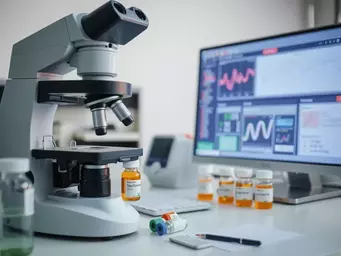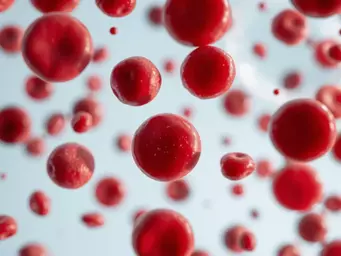Recognizing Early Leukemia Symptoms

As one of the most critical aspects of health awareness, understanding leukemia is essential for timely diagnosis and effective treatment. Early symptoms can be subtle, but recognizing them can significantly impact outcomes. Let's explore the key insights that can empower you on this journey.
What You Will Learn
- Leukemia is categorized into acute and chronic types, each with distinct symptoms and progression rates.
- Common symptoms include fatigue, unexplained weight loss, fever, and night sweats; less common symptoms may be bone pain and headaches.
- Early detection significantly improves treatment effectiveness and overall prognosis.
- Patient advocacy and open communication with healthcare providers are crucial for addressing concerns and ensuring proactive health management.
Leukemia Types and Symptoms
An overview of the main types of leukemia and their corresponding symptoms, highlighting the importance of early detection.
Acute Leukemia
Onset: Rapid, demands immediate treatment.
Severity: Severe symptoms, urgent care required.
Key Types:
- Acute Lymphoblastic Leukemia (ALL)
- Acute Myeloid Leukemia (AML)
Common Symptoms:
- Fatigue
- Unexplained weight loss
- Fever & night sweats
- Frequent infections
Chronic Leukemia
Onset: Slow progression, may be monitored.
Severity: Mild symptoms initially, managed over time.
Key Types:
- Chronic Lymphocytic Leukemia (CLL)
- Chronic Myeloid Leukemia (CML)
Less Common Symptoms:
- Bone & joint pain
- Pale skin & headaches
- Enlarged spleen & liver
- Swollen lymph nodes
Common Treatment Options
Chemotherapy
Targeted Therapy
Stem Cell Transplant
Early detection significantly improves treatment effectiveness and overall prognosis.
Understanding Early Leukemia Symptoms and Their Importance
Understanding leukemia can be a daunting task. It's essential to have a clear grasp of what this blood cancer entails, especially since early symptoms can often go unnoticed. At What Is Leukemia, I strive to provide valuable insights to help you navigate through this complex topic, making the information more approachable and less intimidating.
Leukemia is a type of cancer that affects the blood and bone marrow, characterized by the overproduction of abnormal blood cells. There are several types of leukemia, each with its own unique traits. For detailed information on adult acute lymphoblastic leukemia treatment, you can refer to resources from the National Cancer Institute. In this section, we'll break down what leukemia is and why recognizing early symptoms is crucial for improving treatment outcomes.

What is Leukemia? Overview of Blood Cancer Types
Leukemia primarily falls into two categories: acute and chronic. Each category can be further divided into different subtypes based on the specific characteristics of the cells involved. The main types include:
- Acute Lymphoblastic Leukemia (ALL): Most common in children, but can occur in adults.
- Acute Myeloid Leukemia (AML): Affects both adults and children, known for its rapid progression.
- Chronic Lymphocytic Leukemia (CLL): Typically occurs in older adults, often without immediate symptoms.
- Chronic Myeloid Leukemia (CML): Characterized by the overproduction of myeloid cells, primarily affecting adults.
Understanding these types helps in recognizing the specific symptoms and risks associated with each, guiding patients and their families toward better awareness and proactive health measures.
The Role of Early Detection in Improving Outcomes
Early detection of leukemia can significantly impact treatment effectiveness and overall prognosis. When symptoms are identified early, patients have a better chance of responding positively to treatments. This awareness can lead to more timely interventions, which is crucial in managing complex diseases like leukemia. You can learn more about leukemia and its early detection by exploring resources like those from American Family Physician.
I often share with my patients that being proactive about health is empowering. It transforms fear into action. Regular check-ups and being aware of the signs and symptoms can lead to early diagnosis, which ultimately enhances treatment options and outcomes.
Understanding Different Types of Leukemia: Acute and Chronic Variants
As previously mentioned, leukemia exists in acute and chronic forms, each with distinct symptoms and progression rates. Acute leukemia develops quickly and demands immediate treatment, while chronic leukemia progresses more slowly, allowing for the possibility of monitoring without immediate intervention. Here's a breakdown of what distinguishes them:
- Acute Leukemia: Rapid onset, severe symptoms, requires urgent care.
- Chronic Leukemia: Slow progression, may have mild symptoms at first, often managed over time.
By understanding these differences, you can be more attuned to the specific signs that may arise, further empowering you in your health journey. For additional insights into leukemia, you might find valuable information from the National Center for Biotechnology Information. Remember, knowledge is a powerful tool in the fight against leukemia.
We Want to Hear From You!
What do you think about the importance of understanding early leukemia symptoms? Share your thoughts below:
Summarizing Key Points on Early Leukemia Symptoms
As we reflect on the early symptoms of leukemia, it's important to grasp both the common and less common signs that can emerge. Recognizing these symptoms early can be a game-changer in treatment outcomes. Many patients experience fatigue, unexplained weight loss, fever, and night sweats, which can easily be dismissed at first. However, each symptom serves as a vital piece of the puzzle in understanding one’s health.
- Common Symptoms: Fatigue, weight loss, fever, night sweats
- Less Common Symptoms: Bone pain, headaches, abdominal pain
- Other Indicators: Swollen lymph nodes, frequent infections
Understanding these nuances is essential. For instance, symptoms like bruising and bleeding can indicate low platelet levels, while swollen lymph nodes may signify that the body is fighting something more serious. Each of these signals is worth paying attention to!

Recap of Common and Less Common Symptoms
To summarize the symptoms we’ve discussed, both common and less common symptoms play crucial roles in the diagnosis of leukemia. Common symptoms, like extreme tiredness and unexplained weight loss, often prompt individuals to seek help. Less common symptoms, like bone and joint pain or headaches, might be overlooked but are equally important in recognizing potential leukemia. Here’s a quick recap of these signs:
- Common Symptoms:
- Fatigue
- Unexplained weight loss
- Fever and night sweats
- Less Common Symptoms:
- Bone and joint pain
- Pale skin and headaches
- Enlarged spleen and liver
Being aware of these symptoms empowers you to take action sooner rather than later. Remember, it’s always better to consult a healthcare professional if you have concerns.
The Importance of Early Detection and Seeking Help
Early detection of leukemia can significantly improve treatment outcomes. By recognizing symptoms early and understanding their implications, patients can engage in a proactive approach to their health. Just as I always say at What Is Leukemia, informed patients are empowered patients! It’s essential to advocate for your health and seek medical attention if these symptoms arise.
Furthermore, early intervention can lead to a wider array of treatment options available, ultimately providing a more favorable prognosis. So, if something feels off, don’t hesitate to reach out to your healthcare provider.
Prognosis and Treatment Options: What Patients Should Know
Understanding the prognosis and available treatment options is crucial for anyone navigating a leukemia diagnosis. The journey can be daunting, but knowledge fosters hope! Treatments vary based on the type and stage of leukemia, and may include chemotherapy, targeted therapy, and sometimes stem cell transplants.
- Common Treatment Options:
- Chemotherapy
- Targeted therapy
- Stem cell transplant
It's vital to work closely with your healthcare team to determine the best course of action. Remember, the path to recovery is unique for each individual, and staying informed can help make the process feel less overwhelming.
Frequently Asked Questions (FAQs)
What are the main types of leukemia?
Leukemia is primarily categorized into acute and chronic forms. Acute leukemia includes Acute Lymphoblastic Leukemia (ALL) and Acute Myeloid Leukemia (AML), while chronic leukemia includes Chronic Lymphocytic Leukemia (CLL) and Chronic Myeloid Leukemia (CML).
What are some common early symptoms of leukemia?
Common early symptoms of leukemia include fatigue, unexplained weight loss, fever, and night sweats. Less common symptoms can include bone and joint pain, pale skin, headaches, an enlarged spleen and liver, and swollen lymph nodes.
Why is early detection important for leukemia?
Early detection significantly improves the effectiveness of treatment and overall prognosis for leukemia patients. Identifying symptoms promptly allows for timely interventions and a broader range of treatment options.
What are the typical treatment options for leukemia?
Common treatment options for leukemia include chemotherapy, targeted therapy, and stem cell transplants. The specific treatment plan depends on the type and stage of leukemia.
How can I advocate for my health if I suspect leukemia symptoms?
It's crucial to have open conversations with healthcare providers. Prepare a list of symptoms and questions, be honest about your concerns, and don't hesitate to ask for clarification on medical terms. Seeking support from patient advocacy groups and support communities can also be beneficial.
Taking Action: Your Next Steps for Health Awareness
Now that we've explored the early symptoms of leukemia, it's time to consider how you can take proactive steps towards health awareness. Engaging in open conversations with your healthcare provider is essential. Whether it’s about symptoms, treatment options, or emotional support, don’t hesitate to ask questions!
Encouraging Open Conversations with Healthcare Providers
Starting a dialogue with your healthcare provider can feel daunting. However, it’s a crucial step in ensuring that your concerns are addressed. Here are a few tips to facilitate those conversations:
- Prepare a list of symptoms and questions before appointments.
- Be honest about your concerns and feelings.
- Don’t hesitate to request clarification on medical terms.
These conversations can provide clarity and reassurance, helping you feel more in control of your health journey.
Resources for Further Information and Support
In addition to your healthcare provider, there are numerous resources available for further information on leukemia. Websites like What Is Leukemia provide comprehensive, doctor-reviewed materials that can help you understand the disease better. Additionally, consider reaching out to local libraries or community health centers for educational materials.
Support groups, both in-person and online, can also be invaluable. Connecting with others who share similar experiences can foster a sense of community and provide emotional support during challenging times.
Patient Advocacy and Support Groups: Finding Your Community
Finding your community can be a lifeline during your leukemia journey. Patient advocacy groups not only provide emotional support but also help keep you informed about your rights and available resources. Here are a few steps to find the right group for you:
- Research local support groups in your area.
- Join online forums dedicated to leukemia discussions.
- Attend community events aimed at raising awareness and support.
Being part of a supportive network can greatly enhance your experience and provide a sense of belonging, making the journey a little less daunting. Remember, you are not alone in this journey, and seeking support is a sign of strength!
Recap of Key Points
Here is a quick recap of the important points discussed in the article:
- Leukemia is a type of blood cancer that can be categorized into acute and chronic forms, each with distinct characteristics.
- Early detection of leukemia symptoms, such as fatigue, unexplained weight loss, and night sweats, can significantly improve treatment outcomes.
- Understanding the common and less common symptoms is essential for timely intervention and effective management of the disease.
- Proactive health measures and open conversations with healthcare providers are vital for navigating leukemia treatment options.
- Support groups and patient advocacy can provide valuable resources and emotional support throughout the leukemia journey.
Popular Posts
 When it comes to navigating health concerns like leukemia, knowledge is your greatest ally. Understa
When it comes to navigating health concerns like leukemia, knowledge is your greatest ally. Understa
 As we step into a new era of leukemia treatment, imagine the potential of groundbreaking therapies r
As we step into a new era of leukemia treatment, imagine the potential of groundbreaking therapies r
 In the intricate world of blood cell functions, understanding their roles not only illuminates our b
In the intricate world of blood cell functions, understanding their roles not only illuminates our b
 What if the key to managing leukemia lies not just in conventional treatments, but in a holistic app
What if the key to managing leukemia lies not just in conventional treatments, but in a holistic app
